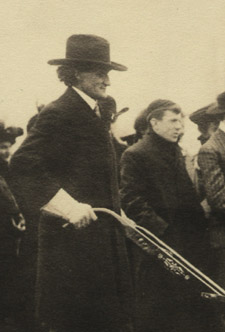
THE EXHIBITIONIntroduction Biography Botany Horticulture Cornell University Nature Study Education of Women Commission on Country Life Hortorium Photography Writings Travel |

|
NY STATE COLLEGE OF AGRICULTUREBailey began making a plea for state-supported agricultural education at Cornell as early as 1893. Bailey and Isaac Roberts built up support by providing bulletins, lectures, demonstrations, farming institutes, and even visits to farmers’ homes. They listened to farmers’ problems and provided valuable solutions. As more and more farmers realized the value of the Extension Program, Cornell’s trustees decided to officially change the name of the university’s Department of Agriculture to College of Agriculture in 1896. By 1900 it was clear that the College of Agriculture required state support to erect the necessary buildings. Early in 1903, Roberts sent Bailey to Albany to secure support for a large agriculture building. The effort failed that year, but by rallying support from all over the state, Bailey succeeded the next year. With Roberts’s retirement in 1903, Bailey became Director of the College. His lobbying skills produced the votes necessary to win over the legislature. And he won not merely $250,000 for the new building, but (over strong opposition from other schools) he was also able to effect the establishment of the New York State College of Agriculture at Cornell University. The new state policy provided ownership and maintenance by the state, but left administration solely to the university. Following dedication of the new college and building by Governor Charles Evans Hughes in April 1907, Bailey set about expanding the faculty, adding new departments, and stimulating innovative research and inspired teaching.
|
||
 |
This exhibition is made possible through a generous gift in memory of Lelah A. Cole.
© 2004 Division of Rare & Manuscript Collections. If you have a question or comment, please contact us. | Web Accessibility Assistance |